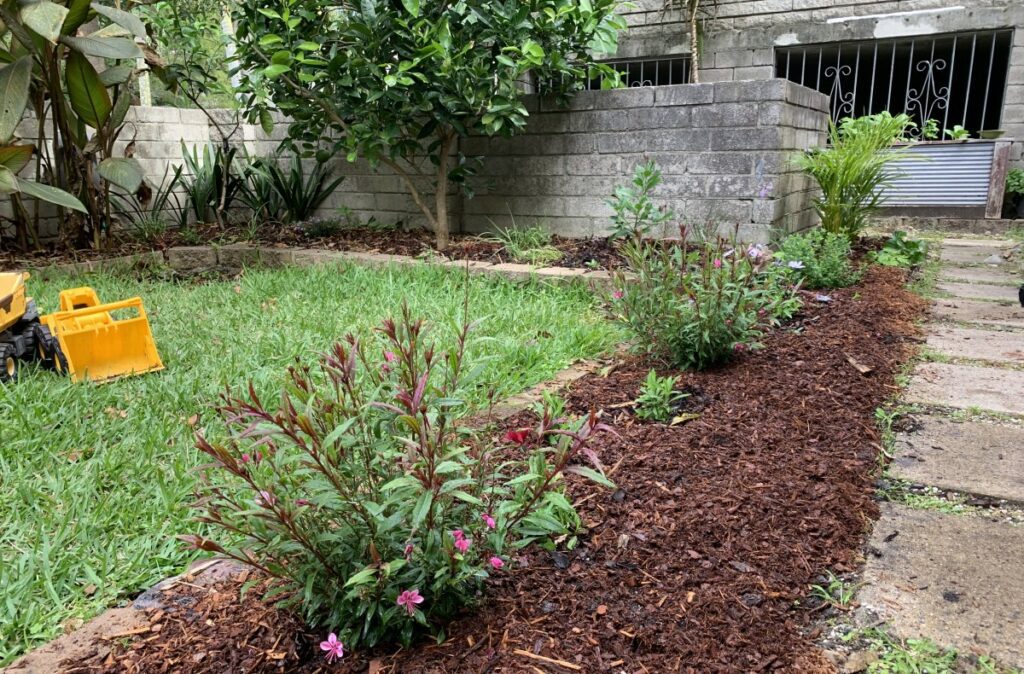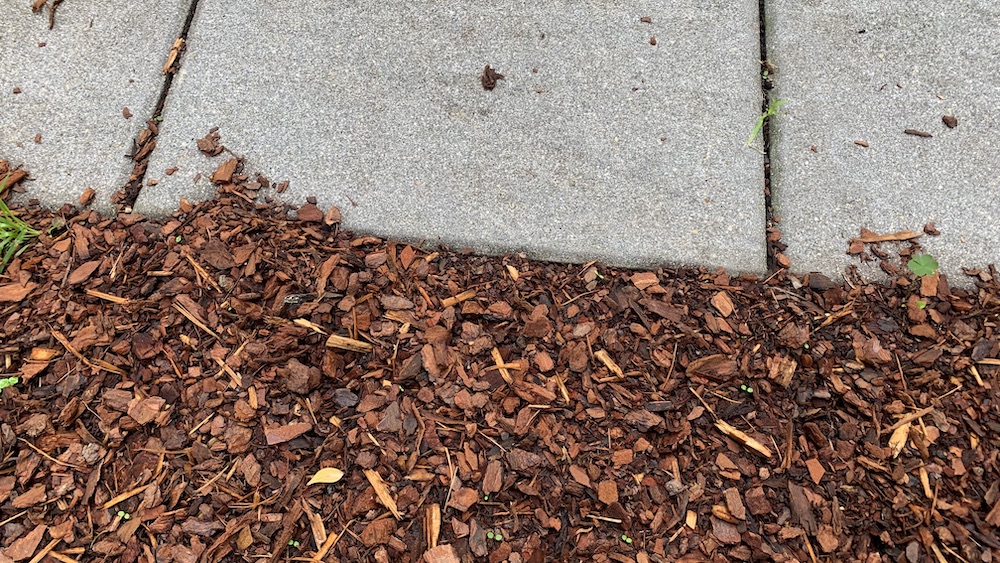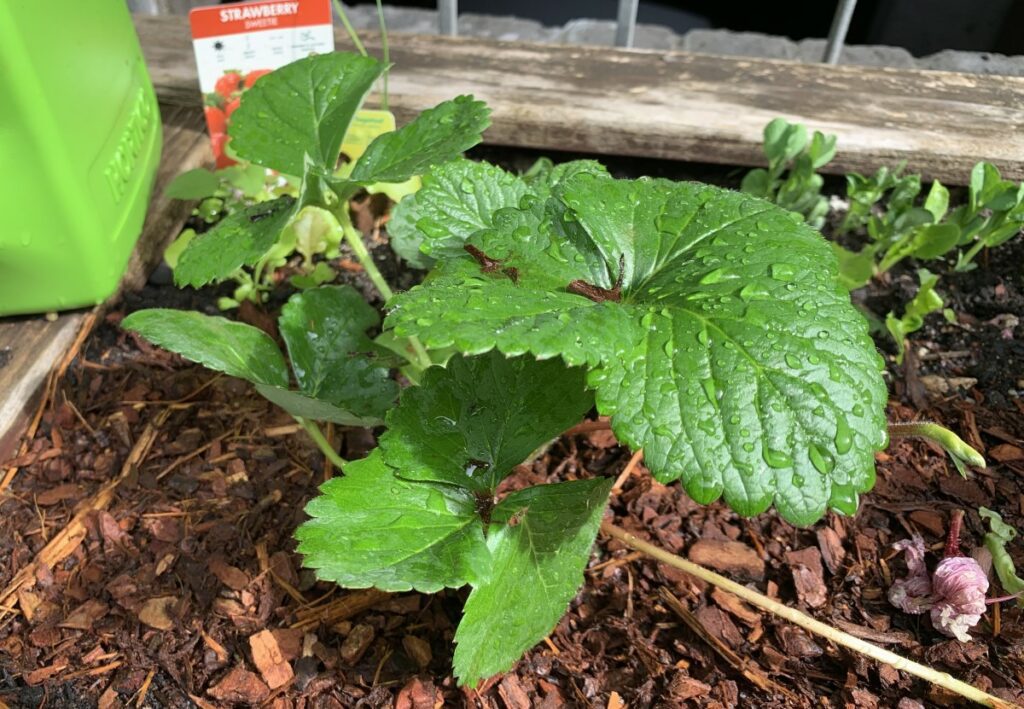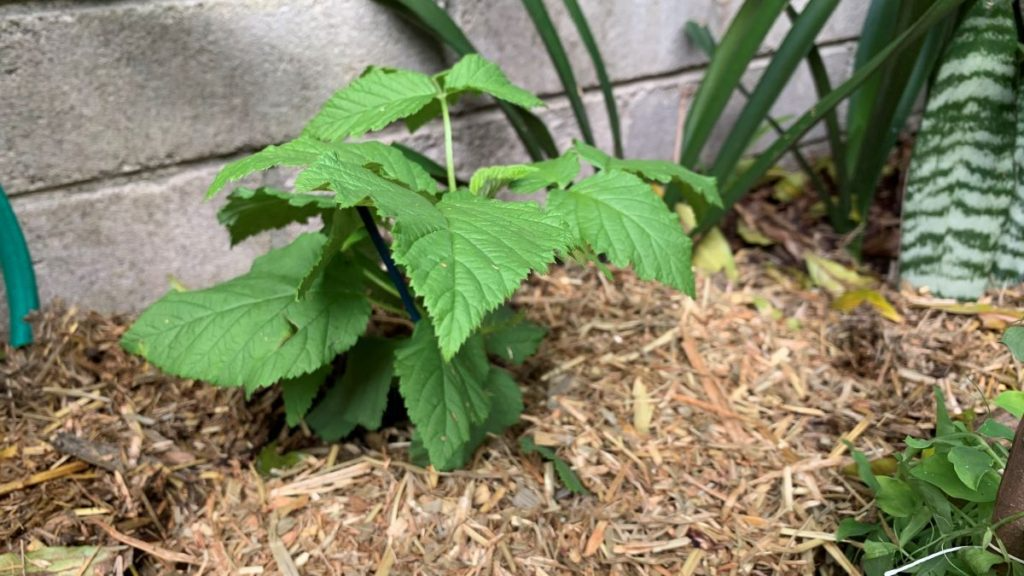Water after mulching trees, shrubs or vegetable seedlings. Watering will keep the mulch in place and stop it blowing away. Lay the mulch 2-3 inches thick and keep it 2 inches away from the plant stem to prevent stem rot. Lay mulch first and finish with watering to settle soil in around your plant’s roots.

Role of Water in Mulching
Watering after mulching in my experience is the best method. It helps to settle the mulch and will water in new or established plants. When you water the plants, the water seeps through the mulch and reaches the soil. This helps to keep the soil moist and provides a favorable environment for the plants to grow.
Water also helps to keep the mulch in place. It will start the breakdown process where soil bacteria and worms work together to turn the mulch into food for the plants. You can water after mulching flower beds, raised beds, vegetable gardens or established trees. Whether you are using straw, hay, bark mulch, pine needles or aged cow manure, watering after is the best method.
Water After Mulching
When it comes to watering your plants, it’s important to know the best time to do it. Watering after mulching is generally recommended. Here are some things to know about when to water.
Advantages of Watering After Mulching
- Retains moisture: Mulch helps to retain moisture in the soil, reducing the need for frequent watering. Watering after mulching ensures that the moisture is locked in, providing a consistent supply of water to your plants.
- Helps to settle the mulch: Watering after mulching helps to settle the mulch in place, preventing it from blowing away or washing away during heavy rain.
- Protects against weeds: Mulch helps to suppress weed growth by blocking sunlight and preventing weed seeds from germinating. Watering after mulching helps to activate the mulch, allowing it to form a barrier against weeds.
Disadvantages
- May cause fungal growth: Watering after mulching can create a moist environment that is conducive to fungal growth. To prevent this, it’s important to water deeply and infrequently rather than lightly and frequently.
- May attract pests: Moist mulch can attract pests such as slugs, snails, and earwigs. To prevent this, avoid overwatering and keep the mulch away from the stems of your plants.
Overall, watering after mulching is a good practice that can help to conserve water, protect against weeds, and settle the mulch in place. However avoid adding too much water as this can cause problems.

Benefits of watering after mulching your plants
Watering your plants after mulching is best as it will help to hold the mulch in place. Although the mulch will soak up some of the water, most of it will reach the plant roots and at the same time settle the mulch in.
Watering after adding light mulch like straw or hay is important as, it can easily blow away even in light winds. Bark mulch can also be blown away in windy areas so watering the plant after mulching helps to hold it in place.

Watering before mulching has several advantages:
- Moisture retention: Watering before mulching will help retain moisture in the soil, which is crucial for plant growth and development.
- Easier mulch application: A moist soil bed makes it easier to apply mulch, as it will stick to the soil and not blow away.
- Better weed control: A moist soil bed will help the mulch settle in and form a barrier against weeds.
- Improved plant health: Watering before mulching can improve plant health by providing the necessary moisture for growth and development.
I always water after applying mulch for all plants including fruit trees, flowers and vegetables.
How to water after mulching
To water after mulching first apply the mulch to the dry soil around the plant. Mulch should be between 2-3 inches thick to allow water to get through to plant roots. Leave a 1-2 inch gap between the stem of the plant and the mulch to stop the stem from rotting.
Apply the water with a watering can or spray nozzle on your hose. Make sure you add enough to water the whole root area and the top of the mulch.

Leave a gap between the stem of the plant and the mulch to allow water to easily reach the center of the plant. Although some water will be absorbed by the mulch, this will not be a problem if you add enough water.
The benefits of adding mulch will be seen over the next days, weeks and months as the mulch holds more water in the soil and prevents weeds. Keeping the soil moist helps to attract microbes and worms which will break down the mulch over time.
When the mulch breaks down will add extra organic matter and nutrients to the soil for your plants. Light mulches like straw, hay or sugar cane mulch will all add organic matter to the soil quickly. Longer lasting mulches like bark mulch will break down into the soil over 6-12 months.
Can you water before mulching?
You can water before mulching if you choose. Watering before mulching will let you see where the water is going and it won’t be absorbed by the mulch before reaching the roots. If mulch is added after watering however it will stay dry and has the potential to move or blow around. If you mulch after watering it is best to spray the mulch lightly with your hose to hold it in place.

Does water seep through mulch?
Water will easily seep through mulch if the mulch layer is around 2-3 inches thick. This will be enough to keep moisture in the soil but also allow rain or water from your hose or watering can to reach plant roots. If the mulch is too thick it can stop water from reaching your plant so remember to keep it at a maximum of 2-3 inches.
Leaving a gap between the plant stem and the mulch will also make extra space for the water to soak through to the roots of the plant.
Do you have to water more with mulch?
When you first water your plant after mulching it is best to give it a little more water than you would without mulch. This will allow for the mulch to soak up a small amount of the water first.
You will need to water the plant with mulch less over time. Mulch will hold moisture in the soil for longer and stop it evaporating quickly off the surface.

How often to water plants
A general rule is to water plants that have been surrounded with a 2-3 inch layer of mulch when the soil has started to dry around 1 inch below the surface. This can be tested by using your finger and digging down into the soil. If the soil feels moist you can wait longer to water.
For small seedlings you may need to water every day. This will depend on the type of seedling and the weather. If you have bought seedlings from a garden center or hardware store they will be used to receiving water everyday. When you plan them out, make sure you keep them well watered for the few 1-2 weeks.
Why mulch is good to save water?
Mulch will keep water in the soil and around your plants longer than if they were not mulched. Mulch will shade the soil and stop evaporation saving water in the long run. They also stop weeds which would otherwise absorb water away from your plants.
Mulch will also help in sloping areas to stop water from running off the surface of the soil when there is very heavy rain. As the mulch breaks down into the soil, the organic matter will help to build up the structure of the soil which in turn will hold more water.

Best mulch to use before watering
The best mulch to use around your plants is an organic mulch like mixed tree mulch, straw, hay, sugar cane mulch or lucerne. These mulches will help to keep moisture in your soil after you water your plants.
For citrus trees, shrubs, native plants and large trees use a mixed bark or tree mulch. This will contain a range of bark chips, branch and leaf pieces which will break down to a rich compost on top of your soil. This mulch is perfect for holding water in the soil for long periods of time.

For vegetables it is best to use a light mulch like, hay, straw or sugar cane mulch to keep the moisture in. This mulch will breakdown quicker and can be dug into the soil after the vegetable has finished the season. These mulches are also great for strawberries as they will keep the soil off the plant and fruit.
Benefits of Mulching
Mulching offers several benefits to plants, including:
- Reducing soil erosion: Mulch helps to protect the soil surface from the impact of raindrops, which can cause soil erosion.
- Controlling weed growth: Mulch helps to suppress weed growth by blocking sunlight from reaching the weed seeds.
- Retaining soil moisture: Mulch helps to retain soil moisture by reducing water evaporation from the soil surface.
- Regulating soil temperature: Mulch helps to regulate soil temperature by insulating the soil from extreme temperatures.
- Adding nutrients to the soil: Organic mulches decompose over time and add nutrients to the soil.
In conclusion, mulching is an essential part of gardening. It offers several benefits to plants, including reducing soil erosion, controlling weed growth, and retaining soil moisture. Mulch can be made from different materials, including organic materials like straw or bark and inorganic materials like rocks or pebbles. Organic mulches are a great choice for established trees, flower beds and vegetable gardens because they decompose over time and add nutrients to the soil.
Summary
Watering your plants after mulching is the best method as the water will hold the mulch in place, hydrate the mulch and help to start the break down process. All mulches work best when they break down and release their nutrients into the soil. Adding water to the mulch will help to build the soil quicker and help soil microbes to grow.
Organic mulches such as bark chips or shredded leaves provide nutrients to the soil as they decompose, adding organic matter. Watering after adding light mulch like straw or hay is important as it can easily blow away even in light winds. Watering after adding heavy mulch like wood chips can help the mulch settle in place and prevent it from drying out too quickly.
It is important to note that mulching is not a one-size-fits-all solution, and different plants have different needs. For example, some plants prefer a drier soil, while others need more moisture. Therefore, it is important to research the specific needs of your plants before deciding when to water them in relation to mulching.
Frequently Asked Questions
Can you spread mulch when it’s wet?
Mulch can be spread when it is wet but it will stick to everything including you. It is much easier to spread mulch when it is dry. For the best result lay mulch before rain so it can be watered in naturally. If there is no rain predicted, water after laying mulch to settle it in. If you need to spread mulch when it is wet, use a wide rake which will help to spread the mulch with less of it sticking to the rake. Wear old clothes and old shoes.
What should I put down before mulching?
Put cardboard or layers of newspaper on the ground before mulching to help to prevent weed growth. These compostable materials will stop weeds for 3-6 months as they break down slowly. They will naturally mix into the soil over time and when you are ready to apply new mulch, you can also lay new newspaper or cardboard to stop weeds.
How long before mulch gets wet?
Mulch laid on garden beds 2-3 inches thick will allow rain to penetrate all the way through to the soil so will get wet during heavy rain. This will help the mulch to break down and feed your soil over time.
Large piles of mulch will slowly soak in rain over time getting wet all the way through eventually. It will take a large amount of rain to reach the bottom of a 4 foot mulch pile. You can move the top layer of mulch away and you may find that the lower levels of the mulch will be dry and easy to spread on your garden.
What is the best time to put down mulch?
It is best to mulch straight after planting new plants or once mulch layers on established plants are less then 2 inches thick. You can then water the mulch and the plants afterwards. If you are expecting large amounts of rain, you can mulch before the rain comes and allow them to be watered naturally.
Should you cover mulch with a tarp?
Mulch can be covered with a tarp until you are ready to use it on your garden to protect it from rain and wind. It is important to allow air movement to the mulch around the edges so that it does not overheat in the sun. Pin the tarp down using tent pegs to stop it from blowing away in strong winds.
When should you water plants after mulching?
It is best to water your plants directly after laying down mulch. Watering will help settle the mulch in place and ensure that it does not blow away. Watering will also help the soil retain moisture, which is important for plant growth.
Is it necessary to wet soil before mulching?
It is not necessary to wet the soil before mulching. If the soil is very dry however, you may choose to water you plants briefly before laying mulch and then water again afterwards.
How long should you wait to water after laying mulch?
You should water your plants immediately after laying down mulch. This will help settle the mulch in place and ensure that it does not blow away. After the initial watering, you should water your plants as needed based on the weather conditions. If you live in a windy area choose a heavy organic mulch like large bark chips.
What is the best tool to spread mulch?
The best tool to spread mulch depends on the type of mulch you are using and the size of your garden. A pitchfork or rake is a good tool for spreading mulch such as wood chips. A garden rake is a good tool for spreading lighter mulch such as shredded leaves, hay or sugar cane mulch.
How do you lay mulch over old mulch?
Before laying down new mulch over old mulch, it is important to remove any weeds or debris. Then, use a rake or pitchfork to create a level surface. Finally, lay down the new mulch on top of the old mulch. Water the mulch in with your hose with a spray attachment to help to settle it in.
How do you calculate the amount of mulch needed?
To calculate the amount of mulch needed, measure the length and width of the area you want to cover. Multiply the length by the width to get the square footage. Then, determine the depth of mulch you want to use. Multiply the square footage by the depth to get the cubic feet of mulch needed.
I am an accredited practicing dietitian, experienced gardener and a dedicated cook. I love writing and sharing my experience so you can learn from my successes and mistakes.

Comments are closed.